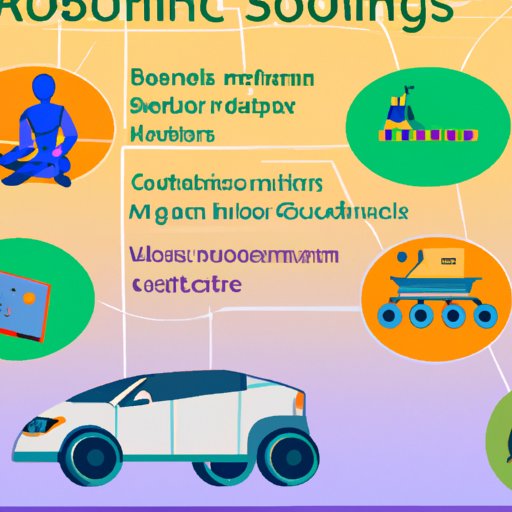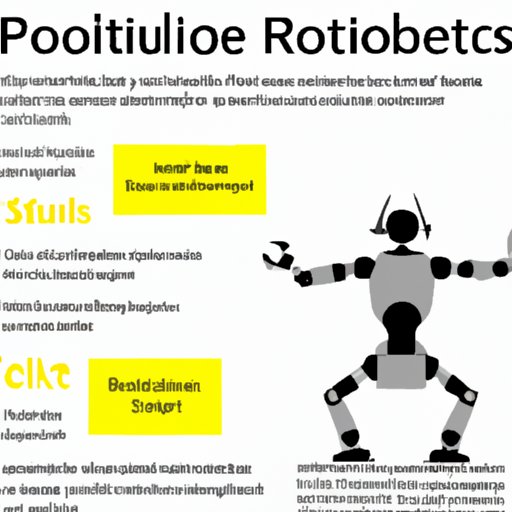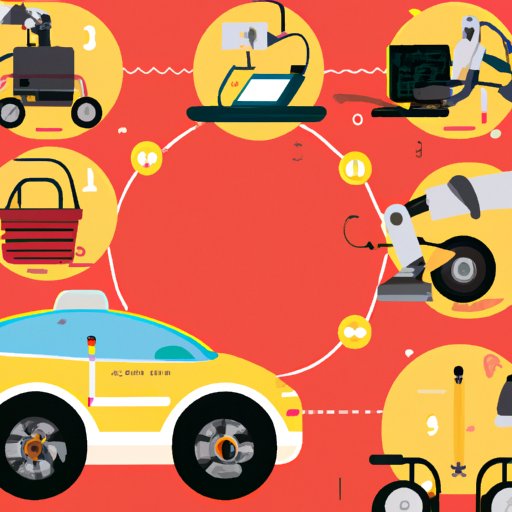Overview of Autonomous Robots: A Definition and History
Autonomous robots are machines that can perform tasks without the need for direct human input or supervision. They are designed to be self-sufficient and capable of carrying out complex tasks on their own. Autonomous robots are increasingly being used in a variety of fields, from industrial and domestic applications to military and medical settings. In this article, we will explore what an autonomous robot is, its types and applications, how it works, and the ethical considerations surrounding its use.
Definition of Autonomous Robotics
An autonomous robot is defined by the International Federation of Robotics (IFR) as “a robot system which, with its own sensors, can identify changes in its environment, decide on appropriate action, and execute that action without further intervention from other sources.” This means that an autonomous robot is able to take in information from its environment and use that information to make decisions and complete tasks without any human input.
History of Autonomous Robotics
The concept of autonomous robots has been around since the 1940s, when Isaac Asimov wrote his famous Three Laws of Robotics. However, the first autonomous robots were not developed until the late 1960s, when roboticist W. Grey Walter built the first autonomous robots called “tortoises.” These robots were able to sense their environment and move around without any human input. Since then, the development of autonomous robots has advanced rapidly, and they are now used in a wide range of industries and applications.
Types of Autonomous Robots: Their Applications and Uses
Autonomous robots come in many different shapes and sizes, and can be used for a variety of purposes. Here are some of the most common types of autonomous robots and their applications:
Industrial Autonomous Robots
Industrial autonomous robots are used in factories and warehouses to automate repetitive tasks such as assembly, welding, and painting. They are typically programmed to follow a set of instructions and can often work 24 hours a day without needing breaks. Industrial autonomous robots are becoming more popular as companies look for ways to reduce costs and increase efficiency.
Domestic Autonomous Robots
Domestic autonomous robots are used in homes to help with everyday tasks such as vacuuming, mowing lawns, and cleaning windows. They are usually smaller than industrial robots and can be programmed to carry out specific tasks. Domestic autonomous robots are becoming increasingly popular as consumer demand for convenience and efficiency grows.
Military Autonomous Robots
Military autonomous robots are used by militaries around the world for a variety of purposes, including reconnaissance, surveillance, and bomb disposal. They are often equipped with sensors and cameras to allow them to navigate hostile environments without putting soldiers in danger. Military autonomous robots are becoming increasingly sophisticated and are being used in a variety of roles.
Mobile Autonomous Robots
Mobile autonomous robots are used in a variety of applications, from healthcare to retail. They are typically wheeled robots that are equipped with sensors and cameras to allow them to autonomously navigate their environment. Mobile autonomous robots are becoming increasingly popular as companies look for ways to reduce costs and increase efficiency.

How Autonomous Robots Work: Technologies and Components
Autonomous robots are made up of several different components that allow them to sense their environment, process information, and make decisions. Here are some of the technologies and components that make up an autonomous robot:
Artificial Intelligence
At the core of an autonomous robot is artificial intelligence (AI). AI is a form of computer science that enables robots to learn from their environment and make decisions without human input. AI allows robots to detect patterns, recognize objects, and respond to their environment in a way that is similar to humans.
Sensors
Autonomous robots are equipped with sensors that allow them to detect their environment. These sensors can include cameras, infrared sensors, and ultrasonic sensors. Sensors allow robots to detect obstacles and changes in their environment, allowing them to react accordingly.
Actuators
Actuators are the components of an autonomous robot that enable it to move. Actuators can include motors, wheels, tracks, and other mechanisms that allow robots to move around. Actuators are essential for enabling robots to interact with their environment.
Control Systems
Control systems are the brains of an autonomous robot. They are responsible for processing data from the sensors and actuators, making decisions, and controlling the robot’s movements. Control systems are typically programmed with algorithms that enable them to make decisions and react to their environment.
Challenges and Opportunities for Autonomous Robots
While autonomous robots have many potential uses, there are also a number of challenges and opportunities associated with them. Here are some of the challenges and opportunities for autonomous robots:
Technical Challenges
One of the main challenges for autonomous robots is their technical complexity. Autonomous robots require a combination of advanced technologies such as AI, sensors, and control systems in order to function properly. Developing these technologies is a complex and expensive process, and it can be difficult to get them to work together in a reliable and efficient manner.
Regulatory Challenges
Another challenge for autonomous robots is the lack of clear regulations and standards. Autonomous robots are still relatively new, and there are no established regulations or standards for their use. This can make it difficult for companies to know how to properly use autonomous robots in a safe and legal manner.
Economic Opportunities
Despite the challenges, there are also a number of economic opportunities associated with autonomous robots. Autonomous robots can reduce costs and increase efficiency, allowing companies to remain competitive in an increasingly globalized market. Additionally, autonomous robots can open up new markets and create new jobs, as companies look for ways to develop and utilize these technologies.

Autonomous Robotics in Everyday Life: Examples and Case Studies
Autonomous robots are being used in a variety of industries and applications. Here are some examples of autonomous robots in everyday life:
Automated Driving
Automated driving is one of the most visible applications of autonomous robots. Automated vehicles are equipped with sensors and cameras that allow them to detect their environment and navigate safely without the need for a driver. Automated driving is becoming increasingly popular, and many companies are investing heavily in the technology.
Autonomous Vacuuming
Autonomous vacuums are becoming increasingly popular in households. Autonomous vacuums are equipped with sensors and cameras that allow them to detect their environment and clean floors without the need for a person to operate them. Autonomous vacuums are becoming increasingly sophisticated and are able to detect obstacles and adapt to changing environments.
Autonomous Manufacturing
Autonomous robots are being used to automate manufacturing processes. Autonomous robots are able to detect their environment and carry out repetitive tasks without the need for human input. Autonomous manufacturing is becoming increasingly popular, as companies look for ways to reduce costs and increase efficiency.
The Future of Autonomous Robotics: Trends, Predictions, and Implications
Autonomous robots are becoming increasingly sophisticated, and their use is growing in a variety of industries. Here are some of the trends and predictions for the future of autonomous robotics:
Technological Advancements
The technologies that power autonomous robots are becoming increasingly advanced. AI is becoming more powerful, sensors are becoming more accurate, and control systems are becoming more reliable. These advancements are allowing autonomous robots to become increasingly sophisticated and are paving the way for new applications.
Consumer Adoption
As the cost of autonomous robots decreases and their capabilities increase, they are becoming increasingly accessible to consumers. Autonomous robots are becoming more popular in households and businesses, and their use is expected to continue to grow in the coming years.
Ethical Considerations
As autonomous robots become more widespread, there are a number of ethical considerations that must be addressed. Autonomous robots can have a profound effect on society, and it is important to consider the implications of their use.

Ethical Considerations for Autonomous Robotics
There are a number of ethical considerations that must be taken into account when using autonomous robots. Here are some of the most important ethical considerations for autonomous robotics:
Respect for Human Life
Autonomous robots should always be designed and used with respect for human life. Autonomous robots should never be used to cause harm or injury to humans, either directly or indirectly.
Privacy and Security
Autonomous robots should be designed and used in a way that respects the privacy and security of individuals. Autonomous robots should not be used to collect or share personal information without consent.
Accountability and Responsibility
Autonomous robots should be designed and used in a way that makes it clear who is accountable and responsible for their actions. Companies should ensure that they are held responsible for any harm or injury caused by their autonomous robots.
Conclusion
Autonomous robots are becoming increasingly sophisticated and are being used in a variety of industries and applications. While there are a number of challenges and opportunities associated with autonomous robots, their use is growing and they are becoming more accessible to consumers. It is important to consider the ethical implications of their use and ensure that they are designed and used in a way that respects human life, privacy, and security.
(Note: Is this article not meeting your expectations? Do you have knowledge or insights to share? Unlock new opportunities and expand your reach by joining our authors team. Click Registration to join us and share your expertise with our readers.)
